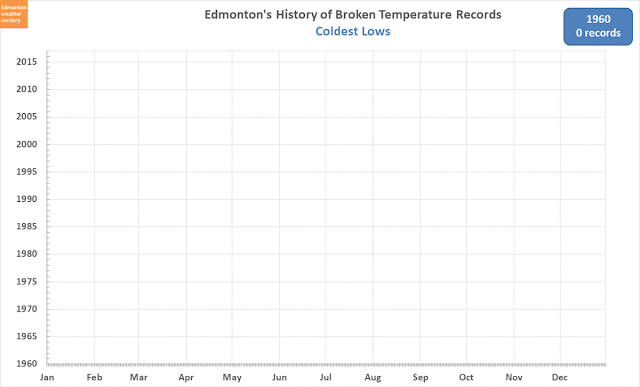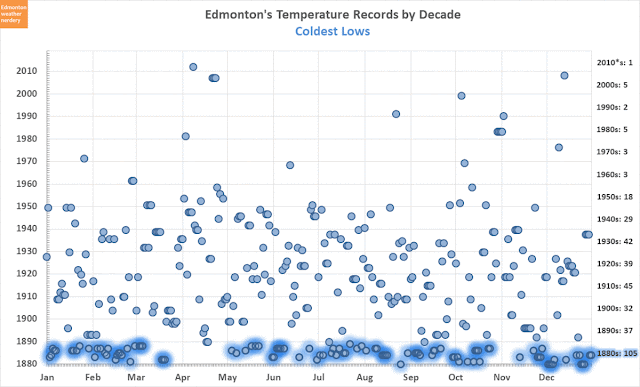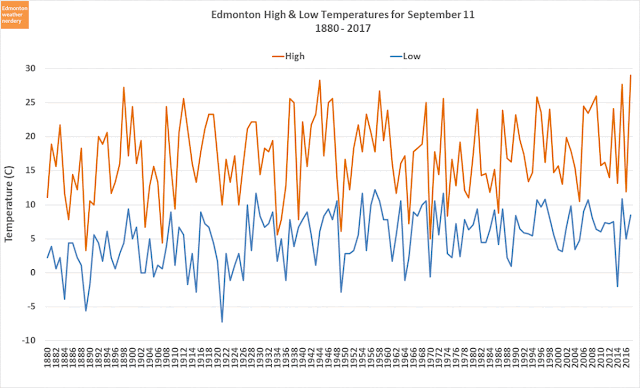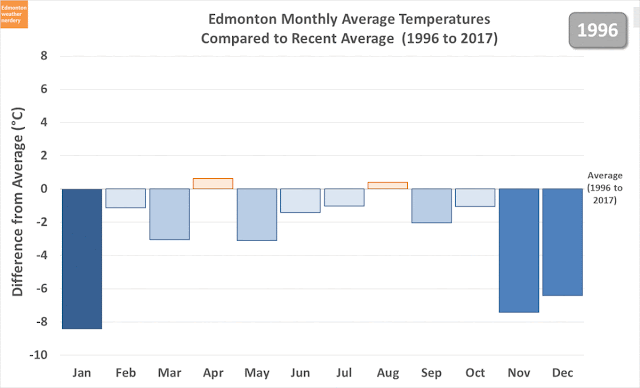To start things off, here is our temperature breakdown for the year:
Yearly Temperature Breakdown
I use this chart a lot, and it shows the average temperature for each day of the year in white, and then in orange a blue are the range of temperatures that we've seen since 1996. The lines furthest out from the average are the all-time warmest and coldest records. Today we'll be looking at the all-time warmest.
Records Compared to their Neighbours
In this chart the focus is on the all-time warmest Highs. It shows each of the records in orange, and then the average for each 7-day period appears in black. The gap between the two is highlighted in red or blue.
There's quite a bit of variation between the records, with plenty of gaps of 3°C or 4°C above or below the average for the week. It's worth keeping in mind just how far above the typical temperatures (visible faintly in white) all of these records are. In the summer the records are all about 10°C above the daily average, and in the winter they're more than 15°C.
In terms of Standard Deviation, there are 30 records here between 1.1-1.5 standard deviations, and 10 that are over 3. Most records are in the range of 2-2.5 standard deviations from the average temperature for their respective days.
Top 10 Warmest Records Compared to Neighbours
Here we have the same chart, but this time the 10 highest gaps are shown.
This year on February 15, 2017 we set a new High temperature record of 16.4°C. In comparison, the records for the rest of that week range from 10.6°C for February 14 and 17, up to 13.3°C for February 16. So the record that we set this year was 4.6°C above the average of its neighbours, which makes it the 4th largest gap.
The largest gap was on December 27, 1999 which set a record of of 16.1°C, which was 6.1°C above it's neighbours.
The oldest extreme record here was set on March 23, 1889, at 22.2°C. 128 years later that record is still 4.8°C warmer than the average of the other records for that week.
These records obviously aren't unbreakable, but they are so much warmer than their neighbours that it might be awhile before they fall. Next we'll take a look at the records that are a bit more vulnerable.
Top 10 Coldest Records Compared to Neighbours
Here we have the low-hanging fruit, with the 10 records that are the furthest below their neighbours.
The most under-achieving record is 13.6°C set on March 24 2004, which is -4.8°C below the average for its neighbours. And we just looked at March 23, 1889 with an over-achieving record of 22.2°C. Between those two days - March 23 and 24 - there is a difference of 8.6°C between the records. Again though, it's import to remember that these are both record High temperatures, and that 13.6°C on March 24 - while low - has never been broken. In comparison, the average High for that time of year is about 6-7°C.
Oldest Records
Last week I'd mentioned that Edmonton has one unbroken High temperature record which goes all of the way back to December 12 1880, at 10.6°C. This chart shows that records, along with the 27 other records which were set in the 1880's.
You might expect that the reason these records have never been broken is because they were all really high, but that's not actually the case. About half of these 120+ year-old records are above their neighbours and about half are below. The December 12, 1880 record is a degree below the average for that week, but on the other hand the March 22 record that we just talked about is 4.8°C above its neighbours.
Last time I'd said that breaking a temperature records always seems like something momentous, and today we've seen that some records are more momentous than others.

































